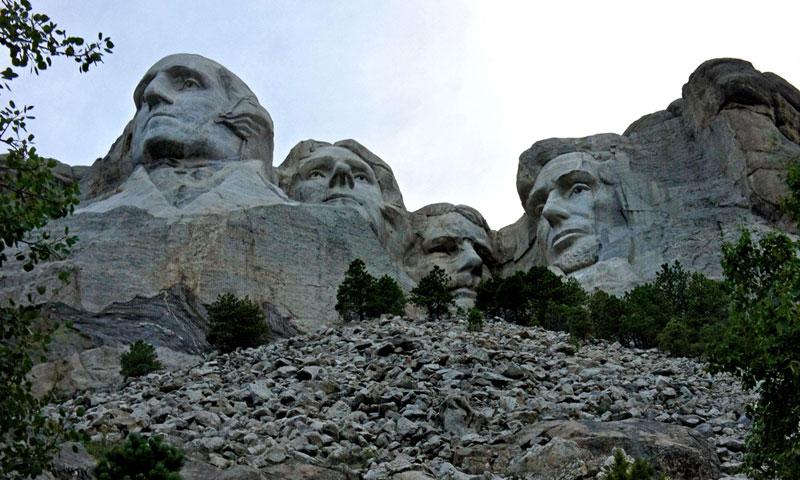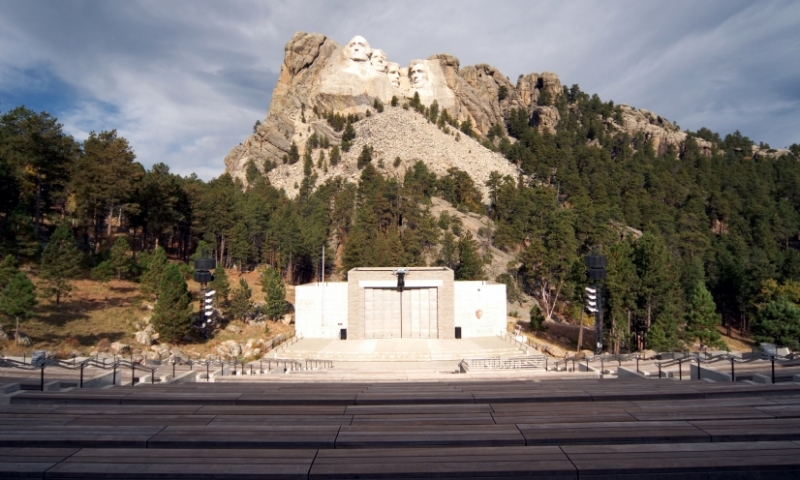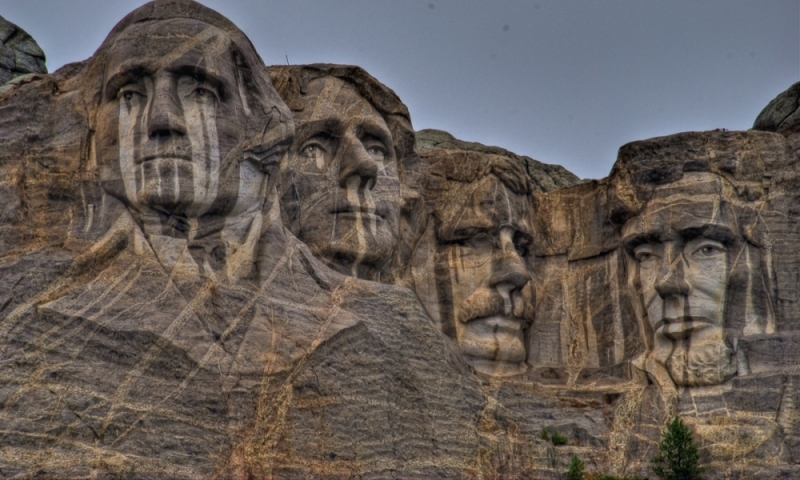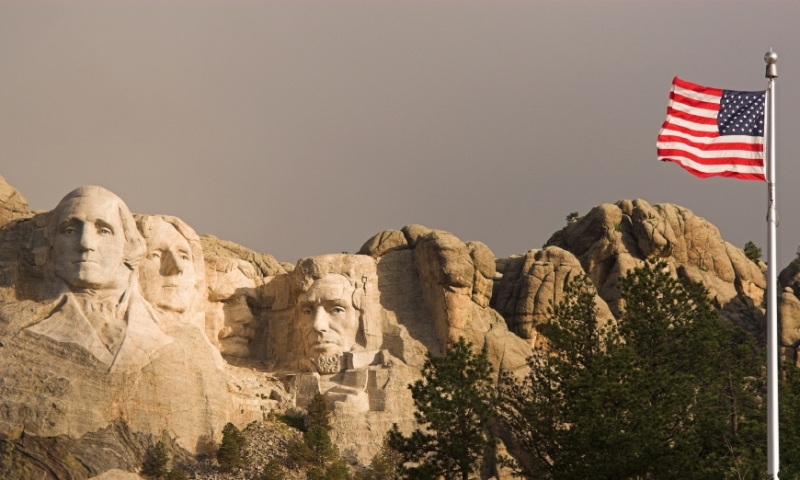What can I see at Mount Rushmore?
Mount Rushmore is one of the most popular national memorials, symbolizing freedom and democracy in America. The Monument features the faces of four United States Presidents – George Washington, Thomas Jefferson, Teddy Roosevelt, and Abraham Lincoln – carved in granite by the late sculptor, Gutzon Borglum, with each chiseled face as tall as a 6-story building.
Completed in 1941, this impressive public sculpture is open year-round, except for Christmas Day. The Presidents’ faces appear the most expressive in the morning and late afternoon sunlight, when the reflection gives them a life-like look. Additional on-site facilities include the sculptor’s studio, a museum, information center, and more.
- During your Mt. Rushmore vacation, be sure to check out all of the on-site facilities, including the Lincoln Borglum Museum (with exhibits on American history, the Cival War, and Indian Wars), or take an audio tour, guiding you through different Memorial features.
- In summertime, check out the sculptor’s studio, showcasing Borglum’s tools and carvings, and the process involved for Mt. Rushmore’s construction.
- Browse the gift shop and then dine at Carver’s Café, or enjoy an ice cream cone from Memorial Team Ice Cream during the summer months.
- Lighting Ceremony: Visit Mount Rushmore at dusk and enjoy the evening lighting ceremony, featuring a ranger-led talk. May – August, 9 pm. September, 8 pm. October – April, illuminated at dusk (no formal program).
How much does it cost to visit?
There is no admission fee to view Mount Rushmore, however a $10 annual parking pass applies.
Where is Mount Rushmore?
Mount Rushmore National Monument is located 23 miles southwest of Rapid City, SD.
- North: From Rapid City, take HWY 16 southwest to Keystone, then follow HWY 244 to Mt. Rushmore.
- South: Follow HWY 385 north to HWY 244. Follow to 244 to Mt. Rushmore.
When is it open?
Mount Rushmore National Memorial is open every day except for December 25.
- Summer Hours (Early-May - late-September): 8 am – 10pm
- Winter Hours (Late-September - early-May): 8 am – 5 pm
- Summer evening program features a lighting ceremony
Who can I call if I have more questions?
Call the Park Headquarters at (605)574-2523 or the Lincoln Borglum Visitor Center (605)574-3165. Visit the website.
Mount Rushmore Monument Facts
Historical Facts
- Mt. Rushmore is one of the most recognized American symbols of democracy.
- The idea for a Black Hills' sculpture came from South Dakota State Historian, Doane Robinson.
- The carving was created by sculptor, Gutzon Borglum, and a team of 400 workers.
- Each morning, workers had to climb 700 stairs to “punch-in” for the day.
- Miraculously, no workers were killed during the project.
- The sculpture took 14 years to complete (Oct. 4, 1927 – Oct. 31, 1941), at a price just under $990,000.
- The monument was named after a New York City attorney, Charles E. Rushmore.
- Climbing Mt. Rushmore is strictly prohibited but that doesn’t stop the occasional climber from trying. They are promptly arrested.
Mount Rushmore Carving Information
- Each Presidential face is as tall as a 6-story building.
- Other dimensions:
Noses – Washington’s nose is 21 feet long, the rest are 20 feet.
Eyes – 11 feet wide
Mouths – 18 feet wide - Borglum and workers used jackhammers, chisels and dynamite to create the sculpture.
- Initially, Jefferson was placed to Washington’s right, however, after 18 months of sculpting Jefferson, workers used dynamite to erase the figure and placed him to Washington’s left.
Sculptor Facts
- Borglum studied art in Paris and became friends with the French sculptor, Auguste Rodin.
- Gutzon died before Mt. Rushmore's completion; his son, Lincoln, put the finishing touches on the monument.
- Borglum campaigned for Theodore Roosevelt’s reelection.
- Borglum’s tools, models, and studio can be viewed at the memorial.
About the Presidents
Although the monument was named after Charles E. Rushmore, the sculpture of Mount Rushmore portrays four Presidents who dedicated their lives to the success of the United States. Mt. Rushmore's Presidents are a constant reminder of America's heritage and values.
George Washington
History Prior To Presidency
1732: George Washington is born in present-day Virginia.
1752: Becomes adjunct general in the Virginia militia.
1754 - 1758: Washington is commissioned as Lieutenant Colonel and leads his men into many battles during the French and Indian Wars.
1759: Washington marries Martha Dandridge Custis.
1775 - 1783: Washington appears at the Second Continental Congress and is ready to lead an army against the British. Washington is appointed Major General and elected to be Commander-in-chief.
1783: The Treaty of Paris is signed; Great Britain recognizes US independence.
1787: Elected as president of the Constitutional Convention.
Term(s) Served
1789 – 1797
Accomplishments
- First US President.
- Helped form a country capable of standing on its own, without the governance of Britain or France.
- Helped create a national bank and tax system.
- Washington solidified in the minds of Americans the importance of the Constitution and the virtues necessary of citizens living together as one Republic.
Interesting Facts
- Washington was a planter and surveryor.
- He was the only US President who did not live in Washington, DC.
- His second inaugural address was only 135 words in length.
Thomas Jefferson
History Prior To Presidency
1743: Thomas Jefferson is born in present-day Virginia.
1752: Jefferson attends a local school and learns Latin, Greek and French.
1760: Attends the College of William and Mary; studies math, metaphysics philosophy and law. He becomes a lawyer.
1768: Jefferson begins construction of his plantation, Monticello. Jefferson instructs some of his slaves in reading and writing.
1775: Jefferson serves as a delegate to the Second Continental Congress and begins early drafts of the Declaration of Independence.
July 4, 1776: Declaration of Independence is approved.
1776 – 1801: Jefferson serves as a Virginia State Legislator, Governor of Virginia, Member of Congress, Secretary of State and US Vice President.
Term(s) Served
1801 - 1809
Accomplishments
- Primary author of The Declaration of Independence.
- Third US President.
- Authorized and supported the Louisiana Purchase and the Lewis and Clark Expeditions.
- Fostered ideas of republicanism and separation of church and state.
- Supporter of state’s rights.
Interesting Facts
- Died exactly fifty years after the signing of the Declaration of Independence.
- Jefferson's personal library (6,000 books) was bought by the US government, forming the basis of the Library of Congress.
Abraham Lincoln
History Prior To Presidency
1809: Abraham Lincoln is born in Kentucky.
1816: Lincoln’s family relocates to Indiana, and a year later, to Illinois. Lincoln is mainly self-educated.
1834: Lincoln wins an election to the Illinois State Legislature. He decides to study law.
1837: Lincoln begins practicing law. During this time he voices his opposition to slavery.
1842: Lincoln marries Mary Todd.
1846: Lincoln is elected to the US House of Representatives.
1860: Lincoln runs for US President.
Term(s) Served
1861 – 1865
Accomplishments and Assassination
- 16th US President.
- Successfully re-united the country after the US Civil War.
- Signed the Homestead Act in 1862.
- Issued the Emancipation Proclamation, abolishing slavery in the United States.
- Delivered the Gettysburg address, one of the most quoted speeches in US history.
- Helped guide the Reconstruction.
- Assassinated in Ford’s Theater in April, 1865, by John Wilkes Booth.
Interesting Facts
- Lincoln was the tallest US President (6 feet 4 inches).
- First President to wear a beard.
- First President to die by assassination.
Theodore Roosevelt
History Prior To Presidency
1858: Theodore Roosevelt is born in New York to a wealthy family. As a child, he suffers from asthma.
1876: Attends Harvard and does well in biological science, with a love for naturalism and ornithology.
1882: Publishes his first book – The Naval War of 1812
1888: Campaigns for Benjamin Harrison. President Harrison then appoints Roosevelt to the US Civil Service Commission.
1895: Serves as President of the board of New York City Police Commissioners.
1897: Appointed as Assistant Secretary of the Navy.
1898: Roosevelt is elected governor of New York.
Term(s) Served
1901 - 1909
Accomplishments
- 26th US President. (Took office after the assassination of William McKinley.)
- Promoted the conservation movement.
- Issued the Monroe Doctrine.
- Passed the Meat Inspection Act and The Pure food and Drug Act.
- Established Oklahoma as the 46th state.
Interesting Facts
- Roosevelt had a photographic memory and loved to read.
- First President to be seen riding in an automobile in public.
Gutzon Borglum’s Early Years
- March 25, 1867 – Gutzon Borglum is born in Idaho to Danish parents.
- Ages 1 – 24: Gutzon receives some formal art training at a private school in Kansas.
- Gutzon’s family moves to California; Gutzon works as an apprentice lithographer before opening his own studio.
- 1888: Gutzon's portrait of General John C Fremont earns him recognition.
- c. 1889: Gutzon marries Elizabeth Putnam, but the marriage dissolves.
Borglum’s Development
- c. 1891: Gutzon studies art in Paris at Academie Julian, where he becomes friends with the French sculptor, Auguste Rodin.
- 1896: Gutzon relocates to England. Some of his pieces are displayed at Windsor Castle.
- 1901: Gutzon returns to the US.
Success
Gutzon continues to develop artistically, creating the following pieces:
- Mares of Diomedes
- An equestrian bronze of General Phil Sheridan, unveiled by Theodore Roosevelt
- A memorial to Pickett’s Charge on the Gettysburg Battlefield
- Wars of America Memorial
- Seated Lincoln
Gutzon is commissioned to create statues for the Cathedral of St. John the Divine in New York. A clergyman accuses Gutzon of failing to portray the angels in a masculine enough fashion and a debate concerning the gender of angels ensues. Gutzon makes the angels more “manly” in appearance.
1909: Gutzon marries Mary Montgomery Borglum.
1912: Borglum campaigns for Theodore Roosevelt’s re-election.
“American” Style/Stone Mountain
- Gutzon experiments with larger pieces, portraying a distinctly “American” style.
- He creates a large sculpture of the head of Abraham Lincoln. The bust is placed at the Capital Building and remains there today.
- Gutzon is approached about doing the head of Robert E. Lee at Stone Mountain, Georgia. Borglum proposes a larger carving, featuring Lee on horseback being followed by soldiers.
- 1923: Gutzon begins work on Stone Mountain, using chisels and jackhammers. A Belgian engineer teaches Borglum how to utilize dynamite in his sculpting process.
- 1924: The head of Lee is unveiled.
- A difference of opinion between Borglum and the project's businessmen results in Gutzon's dismissal. Angered, Gutzon destroys his models and flees Georgia after a warrant is issued for his arrest.
History of Mount Rushmore
- 1923: State Historian of South Dakota, Doane Robinson, hears of Borglum’s work on Stone Mountain and proposes the idea of a mountain sculpture in the Black Hills.
- 1924: Borglum visits South Dakota and agrees to the project.
- 1927: Gutzon begins sculpting and devotes the remainder of his life to carving Mount Rushmore.
- March 6, 1941: Gutzon Borglum passes away.
- After his father’s death, Gutzon’s son, Lincoln, completes the monument's final touches.
The history of Mt. Rushmore is intrinsically linked to one man's artistic vision and talent, and a nation's dedication to the preservation and celebration of democracy. Today, nearly 3 million people visit the site every year, to witness a masterpiece that functions, in Gutzon’s words, “to communicate the founding, expansion, preservation, and unification of the United States with colossal statues of Washington, Jefferson, Lincoln, and Theodore Roosevelt.”











